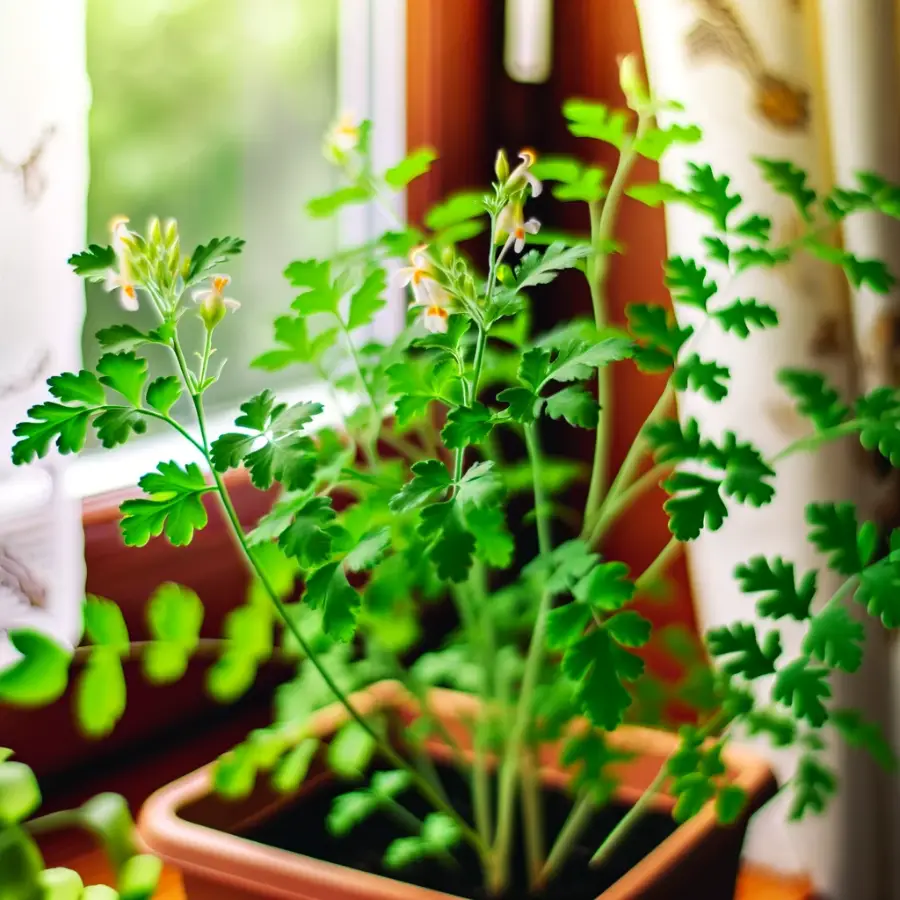Citronella, commonly known for its use in outdoor mosquito-repellent candles, also serves as a versatile and aromatic houseplant. This plant belongs to the Pelargonium genus, often referred to as Pelargonium ‘Citrosum’, though it’s not the true citronella but a scented geranium that mimics the fragrance.
Admired for its lush, green foliage and the lemony scent it emits when its leaves are brushed, citronella can also add a touch of natural beauty to your indoor spaces. Growing citronella inside your home not only helps in potentially warding off mosquitoes but also brightens up window sills, sunrooms, or any area that receives plenty of light.
Light Requirements for Citronella as a Houseplant
Citronella plants thrive when given plenty of light, which is crucial for maintaining their health and enhancing their mosquito-repellent properties. Here are the specific light requirements and some tips for positioning your citronella plant indoors:
Optimal Sunlight Exposure
- Direct Sunlight: Citronella plants prefer a good amount of direct sunlight each day. Ideally, place them in a location where they can receive at least 3-4 hours of direct sunlight, such as a south-facing window.
- Bright, Indirect Sunlight: If direct sunlight is too harsh or not feasible throughout the day, bright, indirect light will also suffice. This can be achieved by placing the plant near a window that gets plenty of ambient light but is shielded from direct rays during the hottest part of the day.
Artificial Lighting
- If natural light is limited, especially in winter months or in naturally darker homes, supplementing with artificial grow lights can be beneficial. These lights should mimic natural sunlight, providing a spectrum of light that supports plant growth.
Adjusting Plant Position
- Monitor Plant Health: Watch for signs that your citronella is not getting enough light, such as leggy growth or leaves that appear to stretch towards the light source. These are indicators that you might need to adjust the plant’s position to a brighter location.
- Seasonal Adjustments: Be mindful of the changing intensity and angle of sunlight throughout the year. You may need to move your plant to different locations in your home to optimize light exposure across different seasons.
By ensuring that your citronella plant receives the right amount and type of light, you can keep it healthy and effective at repelling mosquitoes. Proper light is not only essential for growth but also helps in maximizing the aromatic oils in the leaves, which are responsible for its repellent properties.
Temperature and Humidity Requirements for Citronella
Ideal Temperature Range
- General Range: Citronella plants are adaptable but perform best when indoor temperatures remain between 65°F to 85°F (18°C to 29°C). These temperatures mimic their natural tropical habitat and promote healthy growth.
- Winter Care: When temperatures drop below 50°F (10°C), it’s advisable to move citronella plants indoors if they are not already. This prevents stress and potential damage from cold weather. Citronella can technically survive down to freezing temperatures, but this is not ideal for thriving growth.
Humidity Levels
- Optimal Humidity: Citronella plants benefit from moderate to high humidity levels, ideally between 40% and 60%. This level supports their tropical nature and helps maintain the health of their leaves.
- Managing Indoor Humidity: In drier home environments, especially during winter when heating systems are used, consider using a humidifier or placing a water tray near heating sources to increase humidity. Grouping plants together can also help create a microenvironment with higher humidity.
Adapting to Home Environments
- Temperature Fluctuations: Be mindful of placing your citronella near heat sources like radiators or air conditioning vents, as these can create sudden temperature shifts that are harmful to the plant.
- Light and Temperature: Ensure that the plant’s light exposure is balanced with temperature. Too much direct sunlight in conjunction with high indoor temperatures can stress the plant, whereas adequate light in cooler conditions might be beneficial.
By maintaining the right temperature and humidity levels, you ensure that your citronella plant remains healthy and continues to grow robustly, maximizing its aromatic and mosquito-repelling properties. Regular monitoring and adjustments based on seasonal changes will help sustain an optimal environment for your citronella houseplant.
Watering and Soil Needs
Watering Requirements
- Frequency of Watering: Citronella plants prefer to have their soil kept moist but not waterlogged. During the active growing season (spring and summer), water the plant when the top 1-2 inches of soil feel dry to the touch. Reduce watering frequency during the cooler, dormant months (fall and winter).
- Methods of Watering: Use lukewarm water to avoid shocking the plant’s roots. Water thoroughly until it runs out of the drainage holes, ensuring that the roots are adequately hydrated. Always allow excess water to drain to prevent issues like root rot.
Check also: How to Water Your Indoor Plants
Soil Requirements
- Type of Soil: Citronella thrives in a soil mix that drains well yet retains some moisture. A mix of potting soil, peat moss (or coco coir as a sustainable alternative), and perlite or vermiculite is ideal for providing the necessary aeration and moisture retention.
- pH Levels: The ideal soil pH for citronella plants is slightly acidic to neutral (pH 6.0 to 7.0). You can test the soil pH using a home testing kit and adjust accordingly by adding lime (to raise pH) or sulfur (to lower pH) if needed.
Tips for Optimizing Soil and Watering
- Avoiding Common Problems: Overwatering is a common issue, particularly in cooler months or in less sunny locations, which can lead to root rot. Conversely, under-watering can cause the plant to dry out and become stressed, reducing its growth and aromatic properties.
- Checking Soil Moisture: Use a soil moisture meter or a simple finger test to check moisture levels before watering. This helps prevent over-watering and under-watering, promoting healthier plant growth.
By understanding and managing the watering and soil needs of your citronella plant, you can ensure it grows healthy and strong, maximizing its potential as a natural mosquito repellent and a vibrant houseplant.
Organic Fertilization Schedule for Citronella Plants
Citronella plants benefit from a regular feeding schedule during their active growth phases. Using organic fertilizers not only supports robust growth but also enhances the natural fragrance of the plants, which is vital for their mosquito-repelling properties. Here’s a guide to creating an effective organic fertilization schedule:
Types of Organic Fertilizers
- Fish Emulsion: A fast-acting, nitrogen-rich fertilizer that promotes leafy growth. It’s especially beneficial in the early stages of growth.
- Worm Castings: These provide a more balanced range of nutrients and can be mixed into the soil or used as a top dressing.
- Seaweed Extract: High in potassium, it helps strengthen plant cells and flower development, which is great during the blooming season.
Read more: Best Natural Fertilizers for Indoor Plants
Fertilization Timing
- Spring to Early Summer:
- Begin fertilizing as new growth appears in spring. Apply a balanced liquid organic fertilizer, like a seaweed extract or fish emulsion, once every 2-4 weeks. This supports the initial surge of spring growth.
- Midsummer to Early Fall:
- Continue with regular feeding, especially if the plant is producing flowers or extensive new foliage. Adjust the frequency based on plant response; lush, green growth is a good indicator that your fertilization regimen is working.
- Late Fall to Winter:
- Reduce fertilization as the plant enters dormancy. Ceasing to fertilize in late fall helps the plant to harden off and prepare for colder weather. If you continue to grow it indoors, a very mild feeding once a month or less is sufficient, depending on the plant’s health and indoor conditions.
Application Tips
- Dilution: Always follow the instructions on the fertilizer packaging to dilute organic fertilizers correctly. Over-fertilization can harm the plant, leading to burnt foliage or inhibited growth.
- Even Distribution: When applying liquid fertilizers, ensure even distribution around the base of the plant to avoid concentrated spots that could burn the roots.
- Soil Integration: For granular types like worm castings, work them into the soil around the plant to help integrate the nutrients more effectively with the plant’s root system.
Pruning Guidelines for Citronella to Promote Bushier Growth and Prevent Legginess
Pruning is a critical aspect of maintaining a healthy citronella plant, encouraging bushier growth, and preventing the plant from becoming leggy.
Best Time to Prune
- Early Spring: Pruning should ideally be done in early spring as the plant begins to show new growth. This timing allows the plant to recover quickly and use the growing season to fill out.
- Throughout the Growing Season: Light pruning can be performed throughout the growing season to remove any leggy stems or overgrowth that occurs.
Pruning Techniques
- Selective Pruning: Focus on cutting back the taller stems that are out of proportion with the rest of the plant. This encourages the plant to develop more side shoots from the base, leading to a fuller appearance.
- Pinching: Regularly pinch off the tips of the stems, especially in young plants. This method encourages lateral growth and results in a denser, bushier plant.
- Deadheading: If your citronella blooms, remove spent flowers promptly. This not only improves the plant’s appearance but also promotes more foliage growth, as the plant won’t divert energy into seed production.
Tools and Techniques
- Use Sharp Tools: Always use sharp pruning shears or scissors to make clean cuts. Clean cuts heal faster and reduce the risk of disease entering the pruning wounds.
- Sterilize Your Tools: Before and after pruning, sterilize your tools with rubbing alcohol or a bleach solution to prevent the spread of any plant diseases.
Safety Measures
- Handling: While citronella is generally safe, it’s always a good idea to wear gardening gloves during pruning to avoid any irritation from the plant oils, especially if you have sensitive skin.
Post-Pruning Care
- Watering and Feeding: After a significant pruning session, give your plant a light watering and consider a mild feeding with a balanced, liquid organic fertilizer to support recovery and new growth.
Propagation Techniques for Citronella Plants
Propagating citronella is an excellent way to expand your collection or renew older plants. Here are some effective methods to propagate citronella, each with its own advantages.
Propagation from Cuttings
- Choosing Cuttings: Select healthy stems that are about 4-6 inches long. Choose stems that have several leaf nodes as these areas are where new roots are most likely to emerge.
- Preparation: Cut the stem just below a leaf node using sharp, clean shears. Remove leaves from the lower half of the cutting to prevent moisture loss and potential rot when planted.
- Rooting Medium: Place the stem cuttings in a mixture of peat moss and perlite or use a rooting hormone to encourage root development before planting. You can also start the cuttings in water; however, transitioning them to soil later might be challenging as water-rooted plants need to adjust to a different growing medium.
- Environment: Keep the cuttings in a bright area but out of direct sunlight and ensure the rooting medium is consistently moist. Roots typically begin to form within a few weeks.
Propagation from Seeds
- Sowing Seeds: Although slower than cuttings, starting citronella from seeds is also possible. Sow the seeds in a well-draining seed starting mix, lightly covering them with soil.
- Germination Environment: Place the seed container in a warm, well-lit area, avoiding direct sunlight. Seeds need a consistent temperature and must be kept moist until germination, which can take several weeks.
- Transplanting: Once seedlings have grown strong enough and have at least two sets of true leaves, they can be transplanted into individual pots or outdoor locations, depending on the climate.
General Tips for Successful Propagation
- Humidity and Warmth: Both cuttings and seeds benefit from a warm and humid environment. Covering the pot with a plastic bag or using a propagation tray with a lid can help maintain these conditions.
- Care Post-Propagation: Once roots have established, gradually acclimate the new plants to less controlled environments before moving them to their final growing locations. This hardening-off process reduces shock and improves survival rates.
Common Pests and Diseases Affecting Citronella Plants
Citronella plants, like many other houseplants, can be susceptible to a range of pests and diseases. Here’s an overview of the most common issues and how to address them effectively.
Common Pests
- Aphids: These small, soft-bodied insects tend to cluster on new growth and the undersides of leaves, sucking sap and weakening the plant. They can also spread diseases.
- Spider Mites: These tiny pests cause damage by puncturing plant cells to feed. They are often indicated by fine webbing on the plant.
- Whiteflies: Whiteflies are another sap-sucking pest that can cause yellowing leaves and stunted growth.
Helpful Articles:
Effective Methods to Deal with Aphids
How to Control Pests and Diseases in an Organic Garden
Natural Remedies Against Whiteflies
Common Diseases
- Root Rot: Overwatering can lead to root rot, a serious condition that can destroy the root system of citronella plants, leading to wilting and death.
- Powdery Mildew: This fungal disease appears as white powdery spots on leaves and stems. It typically occurs in hot, dry environments with high humidity. Organic Solutions for Powdery Mildew
Preventive Measures
- Proper Watering: Ensure the soil is well-draining and that you’re not overwatering the plant. Allow the topsoil to dry out between waterings to prevent root rot.
- Adequate Air Circulation: Improve air circulation around your citronella plant to help prevent the growth of mold and mildew.
- Regular Inspection: Check your plants regularly for signs of pests and diseases. Early detection is key to effective treatment.
Treatment Options
- Insecticidal Soap or Neem Oil: For pests like aphids, spider mites, and whiteflies, treatments include spraying the plants with insecticidal soap or neem oil. These treatments are effective and relatively safe for the plant.
- Fungicides: For fungal infections like powdery mildew, use an organic fungicide. Be sure to follow the application instructions provided on the product label.
- Pruning: Remove any infected or dead plant parts immediately to prevent the spread of disease. Dispose of these parts properly and not in your compost bin.
FAQs on Citronella as a Houseplant
Can citronella plants really repel mosquitoes?
Citronella plants are commonly believed to repel mosquitoes, but effective mosquito repellents generally require the leaves to be crushed to release the scent that deters these insects.
How often should I water my indoor citronella plant?
Water your citronella plant when the top 1-2 inches of soil feel dry to the touch. Water less frequently during cooler months when the plant is less active.
What is the best soil mix for citronella plants?
Use a well-draining soil mix that retains some moisture, ideally a mix of potting soil, peat moss or coco coir, and perlite or vermiculite.
How much sunlight does a citronella plant need?
Citronella plants perform best in full to partial sunlight. Indoors, they should be placed in a location that receives several hours of direct sunlight each day.
Can I grow citronella plants indoors all year round?
Yes, citronella plants can be grown indoors throughout the year if they receive adequate light and are maintained at temperatures above freezing.
When is the best time to prune a citronella plant?
Prune citronella plants in early spring to encourage bushier growth and to prevent the plant from becoming leggy.
What are the signs of overwatering in citronella plants?
Yellowing leaves and a wilting appearance despite wet soil are common signs of overwatering, which can lead to root rot if not addressed.
How can I propagate citronella plants?
Citronella can be propagated from cuttings or seeds. Taking stem cuttings and rooting them in soil or water is usually the most effective method.
What should I do if my citronella plant gets a disease?
Remove affected plant parts immediately, improve air circulation, and treat with appropriate fungicides or pesticides depending on the disease.
Is citronella toxic to pets or humans?
Citronella is generally safe around humans and pets, but it can cause irritation if ingested or if sensitive individuals come into contact with the plant.









